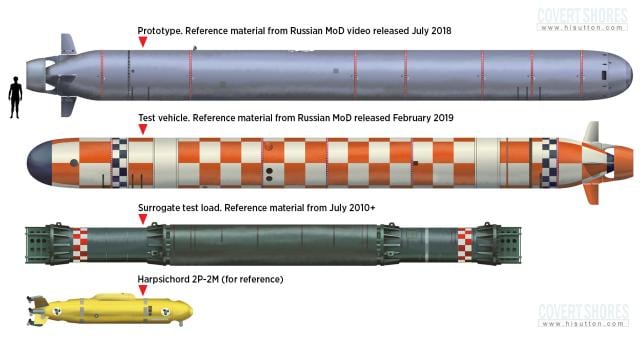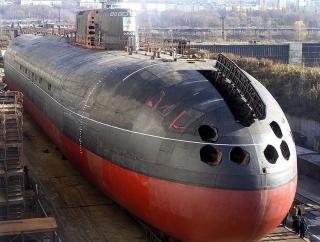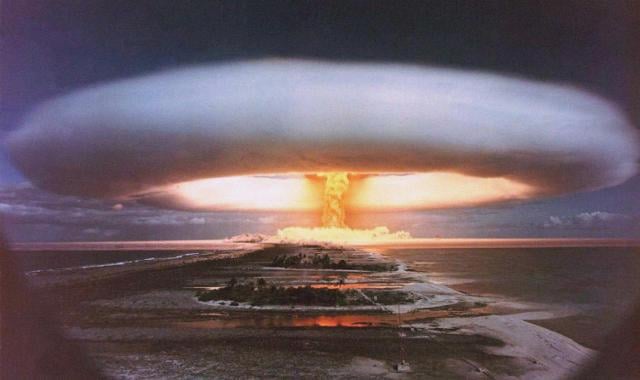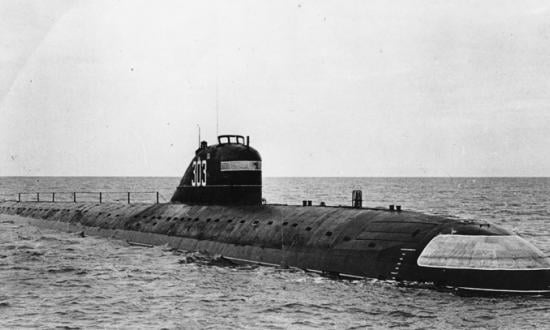New technologies always create questions about capabilities, tactical employment, and countermeasures, but rarely has one created so many simultaneously as has Russia’s Kanyon nuclear torpedo (also called Poseidon or Status-6). While the Soviet Union maintained a nuclear arsenal that included torpedoes carrying nuclear warheads (as did the United States for a time), the Russian Navy has spent years developing a new conceptual approach to these devices. By pairing nuclear warheads with emerging automation, Russia is moving swiftly toward creating an autonomous nuclear deterrent and turning longstanding views of submarine-based nuclear weapons on their heads.
2M39 Poseidon/Status-6 (Ctatyc-6)/Skif (CKM8) seabed launched variant. NATO reporting name: Kanyon. This graphic from analyst H. I. Sutton shows the weapon to scale next to a person (for scale), along with a developmental version, a surrogate load for testing, and a Russian Harpsichord unmanned underwater vehicle. Credit: H. I. Sutton / Covert Shores. Used by permission.
Kanyon breaks all the traditional nuclear deterrence and classification rules. It is a nuclear-powered weapon, therefore possessing theoretically unlimited range. It has the potential to be both a strategic and tactical nuclear weapon and does not fall within the weapon definitions of the New START treaty. Its current launch platform has been converted into a submarine that cannot easily be classified within standard submarine categories. And, perhaps most frightening, this nuclear weapon has the potential for autonomous operation.
History
Russia’s nuclear torpedo development is rooted in Soviet innovations from the mid-20th century. As early as 1951, Soviet designers planned torpedoes with nuclear warheads, in both standard 553-millimeter (21-inch) and larger 1.5-meter (59-inch) diameters. Indeed, early designs for the November-class nuclear-powered attack submarine (SSN) called for it to carry a single 1.5-meter torpedo tube to fire what became the T-15 nuclear torpedo. With a length around 77 feet, the T-15 tube would have taken up a significant portion of the bow of the Novembers, turning them into single-purpose submarines. While Soviet Navy chief Fleet Admiral Nikolai Kuznetsov wrote off the T-15 as impractical, further advances in miniaturizing warheads allowed the Soviet Union to deploy standard-diameter nuclear-armed torpedoes within a few years. By 1962, Soviet officials had publicly indicated that Soviet submarines routinely carried nuclear torpedoes.1
The Soviets also experimented with an entirely different type of nuclear torpedo, the supercavitating VA-111 Shkval. The Shkval used a gas-generating system in its nose to create an air bubble that would envelop the torpedo, allowing its rocket motor to propel it to speeds estimated as high as 200 knots. Capable of carrying a low-yield nuclear warhead, it could be used against submarines or surface ships. In recent years, the Elektropribor Design Bureau has received substantial funding to develop a replacement for the Shkval, known preliminarily as the Khishchnik.
Initial Soviet doctrine appeared to consider the nuclear torpedoes as strategic rather than tactical weapons, but submarine doctrine nonetheless saw U.S. carrier battle groups and other concentrations of the fleet as key targets, and Admiral of the Fleet of the Soviet Union Sergey Gorshkov called for using submarines to engage the enemy fleet.2
One other historical system is important to understand. The Soviet Perimeter system (also known as “Dead Hand”) was an early attempt at creating a semiautonomous nuclear deterrent. Perimeter existed to ensure a second-strike capability—even if Moscow were in flames, with all command-and-control infrastructure destroyed, nuclear retaliation could still be achieved. Through a network of seismic, radiation, and air-pressure sensors, combined with the loss of communication from Moscow, Perimeter would launch communication missiles that would send launch orders to all remaining weapons. While the Soviets never turned off Perimeter’s human controls, the system was capable of fully autonomous operation.
Nuclear Torpedoes Today
The future of Russian sea-based nuclear deterrence is the Kanyon nuclear torpedo. Since 2015, it has drawn the attention of Western analysts for being a nuclear-powered autonomous underwater vehicle (AUV) that carries a nuclear warhead, can target coastal areas, and would not be vulnerable to ballistic-missile defense systems. Despite the seemingly intentional 2015 leak of information, Kanyon is shrouded in secrecy. Russian media reports and Western analysts have nevertheless provided some information about its capabilities. Approximately the same size as the T-15, Kanyon has a reported operating depth greater than 1,000 meters. Some observers claim its speed is as high as 100 knots, although this seems exaggerated because it is not a supercavitating weapon. As analyst H. I. Sutton notes, Kanyon uses a pumpjet rather than a rocket motor, its nose is too blunt, and its control surfaces are too short—so speeds in the range of 60–70 knots would be more likely. Even so, its combination of speed and depth capabilities would put it outside the unclassified envelope for successful engagement by the U.S. Navy’s Mk 48 Advanced Capability torpedo. (Even if the Mk 48 could match Kanyon’s parameters, Kanyon has the advantage of unlimited range, so it would only need to outperform a Mk 48 until the latter ran out of fuel.) Of course, Kanyon is likely to operate at a reduced speed for most of its operational period to minimize noise.
Kanyon’s two obvious distinguishing features are its nuclear warhead and its nuclear propulsion system. The warhead is generally reported as approximately two megatons, though early reports compared it to the Tsar Bomba’s conceptual 100-megaton maximum yield, in part because of the extremely large volume Kanyon’s warhead takes up within the weapon.
The weapon’s reactor design has also been the subject of speculation. One possibility is that Kanyon adapts an experimental Russian project for a liquid-metal-cooled reactor. Russia has a history of using liquid-metal reactors, which provide high-power output in a very compact platform, as the Alfa-class submarines demonstrated. However, this theory does not account for the immense practical problems liquid-metal reactors pose: Soviet Alfas had serious maintenance problems because their lead-bismuth-cooled reactors required superheated steam to maintain a sufficient temperature for the coolant to remain liquid, without which the reactors would be impossible to restart. In theory, submarines carrying Kanyon weapons could produce superheated steam from their pressurized water reactors, but this would require complicated and dangerous high-pressure steam runs through almost the entire length of the submarine. Thus, it seems more likely that Kanyon uses a miniaturized pressurized water reactor.
Strategic Employment and Doctrine
While Kanyon is treated primarily as a strategic weapon, its delivery system obfuscates whether it is a strategic weapon with limited capabilities or also has tactical uses. Kanyon was originally tested using the modified Kilo-class submarine Sarov, and it is expected to be carried operationally by the special-purpose submarine Belgorod (a modified Oscar II guided-missile submarine) and the purpose-built Khabarovsk. At least one additional submarine is expected to be capable of supporting the Kanyon program. Both the Belgorod and Khabarovsk are expected to carry six Kanyons.
Investing heavily in converting expensive nuclear-powered submarines to carry Kanyons makes little sense if the weapon is a nuclear-powered AUV. As such, Kanyon should have practically unlimited range, so it could be launched on patrols far more cheaply from a pier in Polyarny than from a converted Northern Fleet submarine. Further, having multiple Kanyon weapons patrolling the ocean depths independently would create a more distributed and survivable fleet than concentrating them into a limited number of submarines. It is possible concerns about communicating with a submerged nuclear-armed AUV could have led Russian designers to tether Kanyon to a larger submarine, but it would seem cheaper to simply equip the Kanyon fleet with very-low and extra-low frequency receivers of the sort used by most ballistic-missile submarines.
Maintenance concerns also do not seem to justify building a submarine fleet to carry AUVs, as Kanyons cannot be removed from their tubes while the mother submarine is underway. Kanyon therefore appears to be designed with months-long autonomous patrols in mind, but its support infrastructure suggests it is not capable of this employment, at least not yet.
These limitations suggest Kanyon is not yet ready to serve as a fully autonomous nuclear weapon. Rather, its current form may be an intermediate step as Russia continues to develop its AUV technology. Russia has demonstrated substantial interest in unmanned platforms, such as the Harpsichord AUV, and miniaturized platforms such as the Losharik special missions mini submarine, so Kanyon’s development will likely benefit from the lessons these projects teach. In addition, apparent research into seabed deployment of Kanyon suggests Russia is considering alternative means of launching the weapon. This suggests that the relatively small number of submarines designed to carry Kanyon are a sign Russia believes Kanyon will be able to operate fully autonomously at some point. If Kanyon will not permanently require submarine carry, minimizing the number of unique, expensive submarines procured to carry it would allow immediate deployment while minimizing expenditures long-term.
If Kanyon reaches fully autonomous operation untethered from mother submarines, Russia could possess a practically unkillable, autonomous nuclear deterrent. The Perimeter system would be able to independently send orders to Kanyons patrolling the Atlantic and Pacific. Kanyon weapons would then begin fatal runs into U.S. ports from outside the engagement envelope of the U.S. torpedoes that likely would be used to counter them.
A fully operational Kanyon would have an incredible strategic impact. As a new delivery platform, it is not covered by current nuclear arms treaties, including New START. Kanyon could also render current ballistic missile defense systems irrelevant. The submarines that will carry Kanyon are neither ballistic-missile nor attack submarines. An autonomous nuclear weapon delivery system presents both the possibility of an extremely survivable second-strike capability as well as apocalyptic consequences for any system errors that result in inadvertent targeting. While humans likely could still intervene to prevent a nuclear attack, if a fully developed Kanyon were paired with a modernized Perimeter system, the Russian nuclear deterrent would be capable of operating with almost no human input.
. . . and Tactics
Kanyon also could be employed in a tactical role. This would certainly explain the development of expensive mothership submarines, and it also would be consistent with Soviet doctrine, which sought to counter U.S. carrier battle groups. While at first glance it might seem a tactical nuclear-powered torpedo would be a waste of resources, its relative cost to Russia is likely to be far lower than the cost to the United States of a nuclear-powered aircraft carrier and strike group. In addition, a nuclear-powered tactical nuclear torpedo would solve the distance problem that made the T-15 impractical—its short range limited its usefulness, but a weapon of unlimited range would not expose the launching submarine to targeting by carrier escorts or to the blast radius of the warhead. Further, development of the supercavitating Shkval, its replacement Khishchnik, and nuclear warheads for the Kalibr shipborne cruise missile all suggest Russia still has an interest in tactical nuclear weapons, and tactical nuclear torpedoes specifically.
Kanyon may thus serve as a unique combination of strategic second-strike deterrent and tactical nuclear torpedo. Indeed, Russian sources have described Kanyon as a multipurpose system. This makes Kanyon even more destabilizing in the event of war, as its deployment to a conflict zone could represent either the potential for Russian strategic weapons being brought to bear or a more limited tactical deployment.
U.S. Response
Revolutionary weapons such as Kanyon require an effective U.S. response. Merely treating Kanyon as a weapon in the mutually assured destruction system that requires no specific attention would be a poor choice, especially given its potential tactical role. In the early stages of Kanyon deployment, the United States should treat Kanyon motherships like ballistic-missile submarines: They must be constantly tracked by U.S. attack submarines that must be prepared to sink the motherships if required. The limited number of Kanyon-capable submarines will make this task easier, but growing U.S. submarine commitments, especially in the western Pacific, will make it difficult to provide enough attack boats to counter all Russia’s strategic assets without significant additional submarine procurement.
Once Kanyon becomes capable of fully autonomous patrols (or once it has been deployed from its mothership), killing the AUVs will be extremely difficult and will require an integrated defense system. Enhancing submarine torpedo capabilities should be a top priority to provide a better engagement envelope and increase kill likelihood. Aerial antisubmarine warfare platforms should receive weapon systems capable of engaging any Kanyons that they or other assets detect. One innovative suggestion is that both permanent and rapidly deployable passive sonar arrays be combined with self-propelled mines (the Mk 60 CAPTOR concept could serve as the model) to create defensive lines in strategic areas.
In addition, the United States should develop its own nuclear-powered AUVs. This would help by both maintaining a strategic deterrent and presenting a possible countermeasure to Kanyon. Just as the response to strategic missile submarines was to trail them with attack boats, the U.S. Navy could respond to strategic AUVs with attack AUVs designed to hunt for, trail, and—if necessary—destroy Kanyon weapons. This would free more expensive SSNs for other tasks while simultaneously adding additional sensors to the battlespace.
Kanyon’s tactical potential also creates urgency to develop countermeasures. Ranged antisubmarine warfare weapons could use proposed hypersonic glide vehicles to deliver payloads farther from the fleet, negating Kanyon’s speed advantage and keeping its warhead at a standoff range. (In some ways, this would be like Cold War–vintage antisubmarine rocket systems.) In addition, distributing Navy assets—a concept increasingly seen as vital to fleet survivability—would make them less vulnerable to nuclear attack.
Technological revolutions often create strategic instability. Kanyon poses such a risk, but the Navy can and must innovate to respond to this challenge. Developing weapon systems to counter Kanyon must be a high priority, and the improved capabilities the Navy reaps from this development not only will be applicable against Kanyon, but also will be helpful in maintaining strategic and tactical advantages over potential adversaries. Doctrine must advance to account for the unique disruptive effects Kanyon will produce. In the process, the Navy can prove it is ready not just for yesterday’s fight, but for tomorrow’s.
1. James John Tritten, Soviet Naval Forces and Nuclear Warfare: Weapons, Employment, and Policy (New York: Westview Press, 1986), 62.
2. Tritten, Soviet Naval Forces and Nuclear Warfare, 63.









